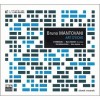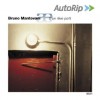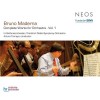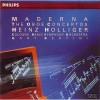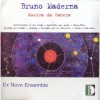Biography
Bruno Maderna (21 April 1920 – 13 November 1973) was an Italian conductor and composer. For the last ten years of his life he lived in Germany and eventually became a citizen of that country.
Maderna was born in Venice. At the age of four he was taught violin in Chioggia, and his grandfather recognized the child's brilliance. He was known in Italy and abroad as "Brunetto" (Italian for Little Bruno).[1]
He continued his studies in Milan (1935), Venice (1939) and in Rome (1940), where he finally took his degree in composition and musicology at the Accademia Nazionale di Santa Cecilia. At Rome he was instructed by Alessandro Bustini, but he also took a course of instruction from Antonio Guarnieri in Siena in 1941, and he then studied composition with Gian Francesco Malipiero in Venice in 1942/43.[2]
During World War II he was drafted into the army, but soon after he voluntarily joined the antifascist Partisan Resistance.[3] After the War, 1947–1950, he taught composition at the Venice Conservatory at the invitation of Malipiero. In those years he taught a large class which included Luigi Nono, who had previously studied law.[4]
In 1948 (through Malipiero[5]) he met Hermann Scherchen, and Maderna and Luigi Nono both attended a course of instruction with him at Venice.[6] Scherchen set Maderna's direction towards dodecaphonic method.[7] He was invited to conduct at the (1951) Internationale Ferienkurse für Neue Musik in Darmstadt, where he took a founding initiative in the Internationales Kranichsteiner Kammer-Ensemble, a chamber-group which was newly re-convened every year as an ad-hoc-Ensemble.[8] Here he met (among others) Boulez, Messiaen, Stockhausen, Cage, Pousseur and the most important performers of the Neue Musik, who inspired him to compose new pieces.
Maderna was a versatile conductor, capable of switching between different musical styles. He directed Purcell's Dido and Aeneas, Wagner's Parsifal, many works by Debussy and Ravel, classical and romantic symphonies. Together with Luciano Berio, he founded the Studio di Fonologia Musicale Rai di Milano (it) of the RAI in 1954:[9] they also organized the Incontri Musicali ('Musical Encounters') music review[10] and concert series.[citation needed]
In 1957/58 he taught dodecaphonic technique at the Milan Conservatory: in this period he also taught composition seminars at the Dartington International Summer School. From 1967 to 1970 he taught conducting at the Salzburg Mozarteum and also at the Rotterdam Conservatory. In 1963 he relocated to Darmstadt in the then West Germany and afterward became a German citizen.[11][12]
He died in 1973 at Darmstadt, when he was about to rehearse Debussy's Pelléas et Mélisande.[citation needed], and during rehearsals for his own opera, Satyricon.[13] Pierre Boulez wrote his Rituel in memoriam Bruno Maderna the following year and Luciano Berio wrote "Calmo" for voice and orchestra in homage to his friend. His notable students include Norma Beecroft and Rocco Di Pietro.
Among the early works is the Concerto per due pianoforti e strumenti (1947–48), influenced by the music of Bartók, which has a special approach towards difficult sonorities. In 1948 he composed his first serial work, the Liriche greche.[14] The Quartetto per archi in due tempi (of 1955) is an even more intensively serial piece.[15]
The flautist Severino Gazzelloni inspired Maderna during the Darmstadt experience.[citation needed] In 1961 he composed Honeyreves for flute and piano: this piece was built on complex flute melodies and on unusual piano sound effects (clusters, playing on the strings, etc.). In the Studio di Fonologia Musicale, with the help of sound technician Marino Zuccheri, he wrote some electroacoustic works: Musica su due dimensioni (Music in two dimensions, 1952, rev. 1957 and 1963) for flute and magnetic tape, Notturno (1956) and Continuo (1958) both for magnetic tape.
In 1962/63 Maderna wrote his first oboe concerto (Concerto for Oboe and Chamber Ensemble). In 1967 he wrote his second oboe concerto, and in 1973 his third.
One of his works is Quadrivium for four percussionists and four orchestral groups (played for the first time at the Royan Festival in 1969). A recording of this work, coupled with the composer's Aura and Biogramma, was made by the North German Radio Symphony Orchestra under Giuseppe Sinopoli in 1979 and issued by Deutsche Grammophon.[16] Among various other compositions are an electro-acoustic divertimento Le Rire (1964), a "work in progress" called Hyperion, and an opera Satyricon. Ausstrahlung for female voice, flute, oboe and pre-recorded tape, based on annonymous Persian poetry was commissioned by the Shiraz-Persepolis Festival of Arts and premiered there in 1971 with Maderna conducting the Hague Residence Orchestra and Cathy Berberian, Koos Verheul and Lothar Faber soloists.
Versatile as Maderna was, he also produced scores for five Italian movies released between 1946 and 1968,[vague] the most important of these being the revolutionary soundtrack for La Morte Ha Fatto L'Uovo (Death Has Laid An Egg), a 1968 psychedelic thriller by Giulio Questi.







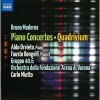
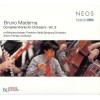
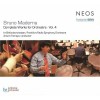
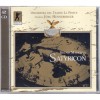
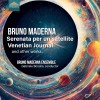
![Bruno Maderna - for strings [Arditti String Quartet]](http://static.classicalm.com/repository/composition-cover/small/26278-img1451736063787592.jpg)
